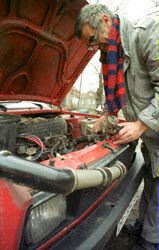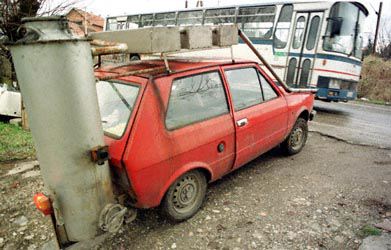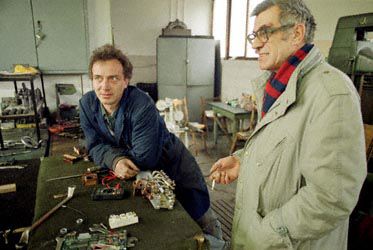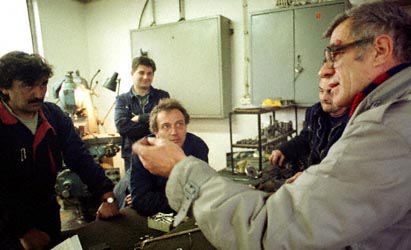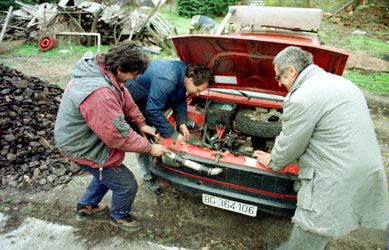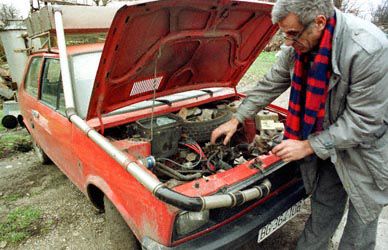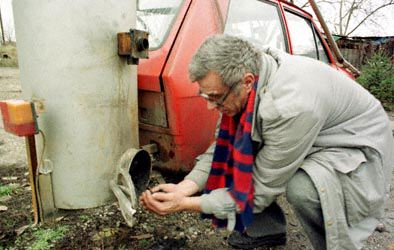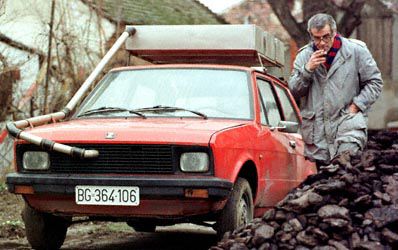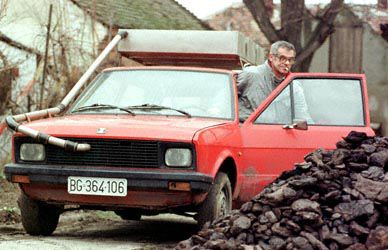|
Mr. Anton Peterka along with his team, made his '85 Yugo 45, using wood and coal for fuel. It's not a new technology, 125 years old.
The process is based on incomplete combustion of wood: due to lack of air, gases are created: carbon monoxide, the main fuels, hydrogen and methane. That mixture of gases is as flammable as gasoline fumes. To get the car moving, it is necessary to "fill it up with wood". The whole mechanism is made of steel plate and it weighs 60 kg. The part in which the wood burns consists of two cylinders. The wood is put in the inner part which is connected to the pipe through which the gas comes to the filters. In the middle part of the cylinder is an opening through which the fire is lit with a torch. Vacuum must be established in the system and therefore the openings for putting in wood and taking out ash are closed with milk can lids (they found a new use here due to their adhesiveness). In the filters, gas is purified (dust and other impurities are removed) and cooled from 250-300oC to 25-30oC (it comes in the engine at that temperature, cool gas is easier to mix with air).
Yugo is the most appropriate to make that transformation, because it has a lot of free space around the engine to host the ventilator which is powered by the car battery and sucks out the gas from the firebox. When the mixture of gases becomes flammable, which can be easily checked with a cigarette lighter, the ventilator is turned off and put in the part where the gas mixture mixes with air in a 1:1 ratio and like the gasoline fumes from the carburetor, which is removed, starts the engine. The gas is not pressurized since the whole process is taking part in a vacuum environment. The only alteration is the gas mixer which is put instead of the carburetor.
Gasoline engines work on a compression ratio 8-10, diesel engines on 17-22 and this gas on 12-13. Gas mixture has about 2590 kJ power, while gasoline gas mixture has 3344 kJ and therefore the engine powered by wood isn't so powerful and instead of 45 HP, decreased to 27-28 HP. The highest speed that can be achieved by that type of an engine is about 85 km/h, because of the less power and the increased weight and air resistance (aerodynamics is disturbed by the external firebox). It takes about 15-20 min to start the car because the wood needs to be decomposed. Capacity of the firebox is 35 kg of wood or coal , which is enough to do 150 km. If the car is left running in place for less than an hour, it is no use turning down the engine - it is left working in neutral.
The really fascinating thing is the fuel consumption and the price difference between these two types of fuel. Instead of 1 litre of gasoline, 2.5 kg of wood is spent. 20 kg of wood are consumed after 100 km which means that driving "on wood" is up to 10 times cheaper than the conventional driving using gasoline. And that is not the only advantage of this kind of driving - exhaust fumes from wood have a lot less harmful components: the environment is being less polluted.
All the functions of the car are the same except as far as the carburettor is concerned. On the roof, you can see filters for gas, avoiding dust, tar, ash and water to enter the carburettor, and also cooling the gas. He worked with his son Igor, who is a mechanical engineer.
|
|||
|
|
|
|
|
|
|
|
||
|
|
|
||
|
|
|
||
|
|
|
||
|
|
|
||
Back to main page E-mail me: yugocars@bigfoot.com


